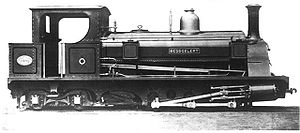0-6-4

Front of locomotive at left
|
|||||||||||||||||

Beddgelert of the North Wales Narrow Gauge Railways
|
|||||||||||||||||
|
|||||||||||||||||
|
|||||||||||||||||
| Equivalent classifications | |
|---|---|
| UIC class | C2 |
| French class | 032 |
| Turkish class | 35 |
| Swiss class | 3/5 |
| Russian class | 0-3-2 |
| First known tank engine version | |
|---|---|
| First use | 1875 |
| Country | United Kingdom |
| Locomotive | Moel Tryfan |
| Railway | North Wales Narrow Gauge Railways |
| Designer | George Percival Spooner |
| Builder | Vulcan Foundry |
| Evolved from | 0-6-2 |
Under the Whyte notation for the classification of steam locomotives, 0-6-4 represents the wheel arrangement of no leading wheels, six powered and coupled driving wheels on three axles, and four trailing wheels on two axles.
The 0-6-4 wheel arrangement appears to have only been used on tank engines and Single Fairlies. The earliest known example was the Moel Tryfan narrow gauge locomotive, built for use on the North Wales Narrow Gauge Railways. It was a Single Fairlie type, built by the Vulcan Foundry near Manchester in 1875. It was followed by the R class and S class, built by the Avonside Engine Company of England for the New Zealand Railways Department between 1878 and 1881.
The South Australian Railways K class locomotives were introduced in 1884, designed by William Thow. They were noted to run more smoothly bunker-first. After the electrification of the Mersey Railway in England, four of its 0-6-4T locomotives were sold to J. & A. Brown of New South Wales, Australia, where one, number 5, is preserved at the New South Wales Rail Transport Museum, Thirlmere, New South Wales.
Three members of New Zealand's S class were also sold to the Western Australian Government Railways in 1891.
...
Wikipedia
